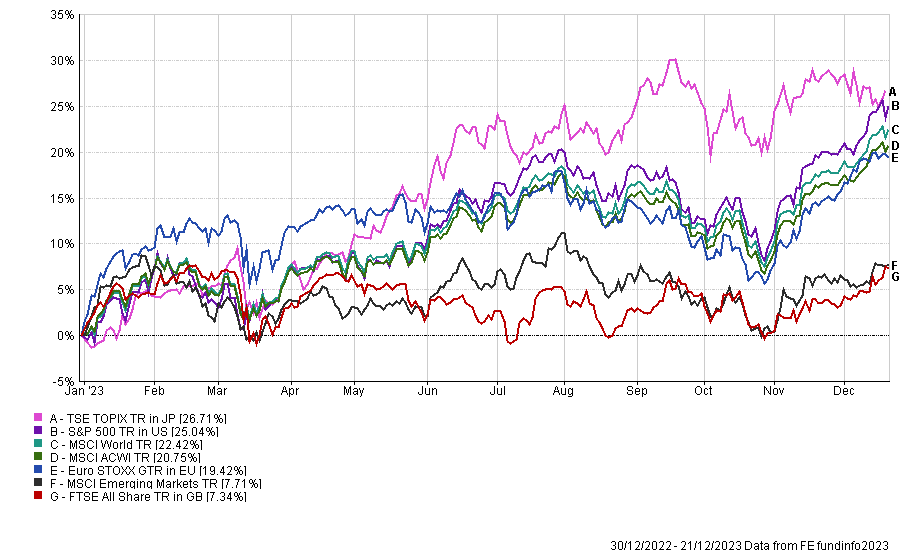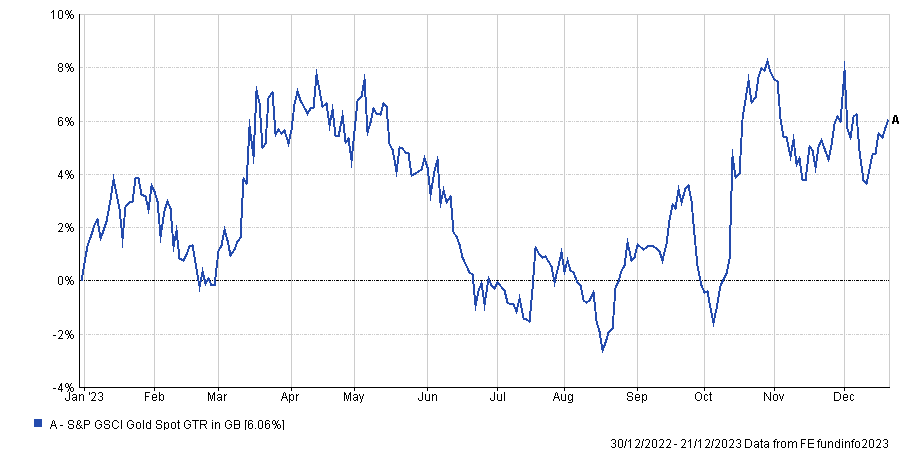UK equities might lag other markets, cash could lose its allure and gold may shine as rate cuts loom while crypto faces a regulatory reckoning in 2024, according to Laith Khalaf, head of investment analysis at AJ Bell.
Although interest rates and inflation appear to have peaked, uncertainties abound, making it difficult to predict the upcoming year. Below Khalaf gives it his best shot.
Will 2024 mark the peak of cash appeal?
While interest rates have reached a proposed peak, Khalaf warned that returns on cash could soon top out as well. Savers revelling in the return of decent yields might not have reached the apex but the tide is turning.
Markets are expecting interest rate cuts in the UK next year and, with inflation potentially tamed, instant access cash rates will inevitably retreat.
Fixed-term accounts, which are more sensitive to future rate changes, are already losing their lustre. One-year bonds have dipped from 5.5% in October to 5.2% and this convergence with instant access rates could reach a tipping point in 2024.
Khalaf said: "It looks likely that in 2024, we'll reach an inflection point where the best rate on fixed-term bonds falls below that on instant access accounts. Indeed, the two have already started converging.
"Without being paid a premium to lock their money away, savers will probably turn away from fixed term bonds in favour of instant access accounts."
Equities: AI boom or bust?
While 2023 saw global equities soar due to artificial intelligence (AI) Khalaf said there could be contrasting fortunes ahead. Once viewed as overvalued, US tech giants continued their ascent in 2023, leaving investors contemplating whether they should stick or twist.
This decision hinges on tech maintaining its earnings magic, with any stumbles such as NVIDIA's recent dip potentially met with harsh market censure. High valuations leave little room for error, making 2024 a potential tightrope walk for the sector.
Meanwhile, the UK market remains in the doldrums, with the FTSE 100 weighed down by banks and miners compared to the NASDAQ's tech pioneers.
Domestic investor sentiment is tepid and global attention has largely shifted elsewhere. Next year offers little hope for a reversal of this longstanding antipathy, with the UK's small slice of the MSCI World Index allowing investors to bypass it easily.
Khalaf added: "That doesn't mean the UK market can't make progress, as it did in the last year with a 6% return. But it might not set the world alight compared to other regions, most notably the US, with even Japan trying to break in on the action."
Performance of indices YTD

Source: FE Analytics
UK Gilts: From calamity to cautious optimism in 2024
After a disastrous 2022, UK government bonds (gilts) have staged a surprising comeback in 2023. Thanks to optimism around falling interest rates, the 10-year gilt yield sits near its starting point of 3.7% despite briefly soaring to 4.7%.
Shorter-dated gilts, particularly appealing to retail investors, offer even higher yields, with the two-year yield reaching 4.3%.
Assuming inflation continues its descent, the yield curve should straighten, rewarding investors for holding longer-dated bonds.
However, the pace and extent of this recovery hinges on the Bank of England's interest rate decisions. While gilts now offer far better returns than in the 2000s, they may still pale in comparison to cash for many retail investors.
Khalaf added: "The yield on gilts should be tempered with some acknowledgement of supply risks, especially in an election year when markets might get spooked by uncosted spending promises.
"As things stand it looks like both main parties will stand on a platform of fiscal prudence, but funny things can happen on the campaign trail."
Will gold fade in 2024?
Despite a lacklustre performance for UK investors in sterling terms (around 6%), gold has enjoyed a double-digit dollar return in 2023.
Khalaf suggested that a weakened dollar boosted prices while the promise of falling US interest rates reduced the "opportunity cost" of holding the non-income-generating asset.
Performance of gold spot YTD

Source: FE Analytics
In the final quarter of 2023 gold rallied 10%, suggesting the market anticipates rate cuts. However, 2024's progress hinges on the timing and extent of these cuts.
Khalaf added: "While gold is often seen as a safe haven, investors need to be careful not to equate this with price stability. People do tend to rush to the precious metal in times of financial stress, but it shouldn't be taken as read that gold isn't volatile."
Will regulations and Bitcoin's halving halt crypto?
Despite scandals and regulatory pressures, crypto has charged forward in 2023. In the UK, planned regulations, while criticised by some, could paradoxically boost crypto by legitimising it and attracting new investors.
Adding fuel to the fire is the upcoming Bitcoin halving in 2024, which will halve the number of new Bitcoins minted.
Bitcoin bulls see this as a significant price catalyst, potentially explaining the recent surge. However, critics argue this event is predictable and already factored into prices.
Khalaf added: "The question is how many of those who invest in these periods actually end up making a profit. It remains the case you shouldn't bet your shirt, unless you're prepared to lose it."




